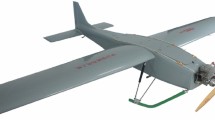Abstract
The number of EMA (Electro-mechanical actuator)-based UAVs (unmanned air vehicle) are on the rise. The EMAs are generally applied to UAV as primary and secondary flight control surfaces actuator, speed or air brake actuator, door actuator, landing gears and so on. Since all EMAs are expressed as 2nd- or 3rd-order simplified mathematical models in M&S (modeling and simulation) phase, dynamic estimation of the EMAs power consumption is almost impossible and it causes battery/generator sizing problems in the design phase. Especially for UAVs that have all EMAs for the primary and secondary flight control actuators, electric power consumption is increased in flight because of hinge moments of the control surfaces caused by air pressure during flight. In this thesis, we provide a method for dynamic power consumption estimation of the primary and secondary control surface EMAs for M&S through the electro-mechanical dynamics and aerodynamics. Not only simulation results but also successful flight test results are presented in this work.











Similar content being viewed by others
References
ER Mueller (2007) Hardware-in-the-loop simulation design for evaluation of unmanned aerial vehicle control systems. AIAA modeling and simulation technologies conference and exhibit 20–23 August 2007, Hilton Head, South Carolina
MA Cooper (2014) Simulating actuator energy demands of an aircraft in flight. Ph.D. Thesis in Cranfield University
Chakraborty I, Mavris DN (2014) A System and Mission Level Analysis of Electrically Actuated Flight Control Surfaces using Pacelab SysArc. AIAA Science and Technology Forum and Exposition (SciTech), At National Harbor, Maryland, USA
Mezher LS (2021) Speed control for servo DC motor with different tuning PID controller with labview. J Mech Eng Res Develop 44(1):294–303
Salloum R, Moaveni B, Arvan MR (2014) Robust PID controller design for a real electromechanical actuator. Acta Polytechnica Hungarica 11(5):125–144
Alarçin F, Demirel H, Ertugrul MS, Yurtseven A (2010) Control of electro-mechanical actuator for aerospace applications. Strojarstvo 52(3):303–313
Cui YB, Zheng J, Ju YT, Xu J (2013) Precise angle control of electromechanical actuator with fuzzy PID and genetic algorithm. Appl Mech Mater 300–301:1479–1485
Xiaofeng Z, Jun Y, Xiaoping Z (2010) Design of fuzzy adaptive controller for high precise electromechanical actuator. J Projectiles Rockets Missiles Guidance 30:30–32
Choudhary K, Qureshi MS, Singh B (2018) Position control of DC servo motor using improved sliding mode control techniques. Int J Appl Eng Res 13(8):15–19
Liu X, Yunjie Wu, Deng Y, Xiao S (2014) A global sliding mode controller for missile electromechanical actuator servo system. Proc Institut Mech Eng Part G 228(7):1095–1104
YC Lee (2007) Design of electrical actuation system for guided missiles using time delay algorithm. Ph.D. Thesis in Chungnam National University
Zhou M, Mao D, Zhang M, Guo L, Gong M (2018) A hybrid control with PID–improved sliding mode for flat-top of missile electromechanical actuator systems. Sensors 18:4449
Han J, Wang H, Jiao G, Cui L, Wang Y (2018) Research on active disturbance rejection control technology of electromechanical actuators. Electronics 7:174
Ristanovic MR, Lazic DV, Indin I (2008) Nonlinear PID controller modification of the electromechanical actuator system for aerofin control with a PWM controller DC motor. Automat Control Robot 7(1):131–139
Mahfouz AA, Mohammed MK, Salem FA (2013) Modeling, simulation and dynamics analysis issues of electric motor, for mechatronics applications, using different approaches and verification by MATLAB/simulink. Int J Intell Syst Appl 5:39
Ortiz X, Hemmatti A, Rival D, Wood D (2012) Instantaneous forces and moments on inclined flat plates. The Seventh International Colloquium on Bluff Body Aerodynamics and Applications, Shanghai
Open-Source Flight Simulator. Retrieved from https://www.flightgear.org. Accessed 1 Oct 2015
Open Source Flight Dynamics Model. Retrieved from http://jsbsim.sourceforge.net. Accessed 11 Sep 2015
Cross-Platform Application Development Framework. Retrieved from https://www.qt.io. Accessed 25 Sep 2015
Author information
Authors and Affiliations
Corresponding author
Additional information
Publisher's Note
Springer Nature remains neutral with regard to jurisdictional claims in published maps and institutional affiliations.
Rights and permissions
About this article
Cite this article
Kang, J.G., Kwon, J.Y. & Lee, M.S. A Dynamic Power Consumption Estimation Method of Electro-mechanical Actuator for UAV Modeling and Simulation. Int. J. Aeronaut. Space Sci. 23, 233–239 (2022). https://doi.org/10.1007/s42405-021-00417-4
Received:
Revised:
Accepted:
Published:
Issue Date:
DOI: https://doi.org/10.1007/s42405-021-00417-4




